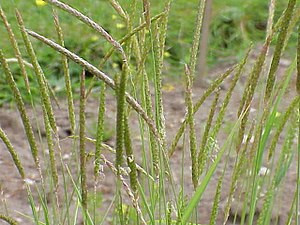Field foxtail grass
| Field foxtail grass | ||||||||||||
|---|---|---|---|---|---|---|---|---|---|---|---|---|

Field foxtail grass ( Alopecurus myosuroides ) |
||||||||||||
| Systematics | ||||||||||||
|
||||||||||||
| Scientific name | ||||||||||||
| Alopecurus myosuroides | ||||||||||||
| Huds. |
The Alopecurus myosuroides ( Alopecurus myosuroides Huds. , Syn. : Alopecurus agrestis L. ) is an annual plant of the genus of alopecurus ( Alopecurus ) within the family of grasses (Poaceae).
features
Field foxtail grass is an annual plant and usually grows annually and in tufts. The stalks reach heights of 15 to 80 cm, are densely branched at the bottom and upright to kneeling and ascending. Its surface is heavily grooved and rough along its entire length. The stalk has three to five knots . The leaf sheaths are rough, the uppermost are slightly inflated, the lowest are very thin. The ligule is a membranous border 2 to 5 mm long. The leaf blades are 4 to 15 cm long and 3 to 8 mm wide. They are flat and rough, especially on the top and edge.
The ear is 3 to 12 cm long, 4 to 6 mm wide and densely cylindrical. The spikelets consist of only one flower . Without awn , the spikelets are 4 to 7 mm long and narrow-elliptical in shape. At maturity they fall off as a whole. The glumes are equal to each other. In the bottom third to half they are fused at the edges. They have three nerves and are as long as the spikelet, lanceolate, with a keel, the wings 0.3 to 0.5 mm wide in the upper half. The keel and lateral nerves are hairy in the lower area. The lemma is four-veined, about the same length as the glume, lanceolate, glabrous. Its edges are fused in the bottom third, the back bears an awn in the bottom quarter. The awn is kneeled, 8 to 12 mm long, the lower awn is twisted, the upper awn is straight, rough and usually protrudes around 4 mm above the spikelet. The palea is absent. The anthers are 2.5 to 4.5 mm long. Flowering time is in May and August / September.
The fruit is 2 to 3 mm long, long, elliptical and laterally compressed. The chromosome number is 2n = 14.
Distribution and locations
The field foxtail grass occurs from Western Europe and the Mediterranean to Central Asia. It was introduced into North America and other areas.
The species is long-established in Central Europe ( archaeophyte ). In the south-west, west and north of Germany, the species is long-established and common. It is often introduced in central and eastern Germany and was previously considered very rare. In Austria it has also long been considered very rare and inconsistent, but it seems to be spreading.
Field foxtail grass grows in grain fields , especially in winter grain . In addition, it is ways in dumps, on fallow and wasteland to find. It grows on moderately fresh, nutrient-rich and alkaline clay soils that are often calcareous , poor in humus and neutral to moderately acidic. It is a half-light plant and a clay pointer .
In terms of plant sociology , it is an association characteristic of the clinging umbel societies (Caucalidion platycarpi), but also occurs regularly in Windhalm societies (Aperion spicae-venti).
In East Friesland , foxtail grass is also known as swart grass .
meaning
Field foxtail grass can appear as a weed in winter cereal fields. When grain is grown multiple times in the fields, it spreads quickly. Control is considered difficult and is usually done by rotating crops .
In conventional agriculture caused by the field foxtail to significant yield losses, because these grass species (presumably to various herbicides glyphosate ) multidrug resistance has developed.
supporting documents
In addition to the sources listed in the individual references, the article is based on the following documents:
- HJ Conert: Parey's book of grasses. Recognize and determine the grasses of Germany. Blackwell Wissenschafts-Verlag, Berlin, Vienna 2000, p. 192, ISBN 3-8263-3327-6
Individual evidence
- ↑ a b Erich Oberdorfer : Plant-sociological excursion flora for Germany and neighboring areas . With the collaboration of Angelika Schwabe and Theo Müller. 8th, heavily revised and expanded edition. Eugen Ulmer, Stuttgart (Hohenheim) 2001, ISBN 3-8001-3131-5 , pp. 258 .
- ↑ Rafaël Govaerts (Ed.): Alopecurus myosuroides. In: World Checklist of Selected Plant Families (WCSP) - The Board of Trustees of the Royal Botanic Gardens, Kew . Retrieved November 7, 2016.
- ^ CE Hubbard: Grasses. A Guide to their Structure, Identification, Uses and Distribution in the British Isles . Penguin, London 1992, p. 235, ISBN 0-14-013227-9
- ^ Manfred A. Fischer , Karl Oswald, Wolfgang Adler: Excursion flora for Austria, Liechtenstein and South Tyrol. 3rd, improved edition. State of Upper Austria, Biology Center of the Upper Austrian State Museums, Linz 2008, ISBN 978-3-85474-187-9 .
- ^ Carl Jessen : The German folk names of plants , published by Philipp Cohen Hannover 1882, page 22
- ↑ Super weed: The farmer's nightmare on daserste.de
Web links
- Field foxtail grass. In: FloraWeb.de.
- Field foxtail grass . In: BiolFlor, the database of biological-ecological characteristics of the flora of Germany.
- Profile and distribution map for Bavaria . In: Botanical Information Hub of Bavaria .
- Alopecurus myosuroides Huds. In: Info Flora , the national data and information center for Swiss flora . Retrieved September 30, 2015.
- Distribution in the northern hemisphere according to Hultén
- Thomas Meyer: Data sheet with identification key and photos at Flora-de: Flora von Deutschland (old name of the website: Flowers in Swabia )


